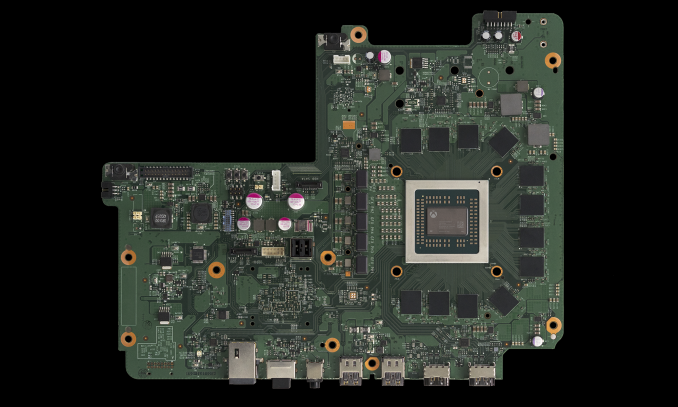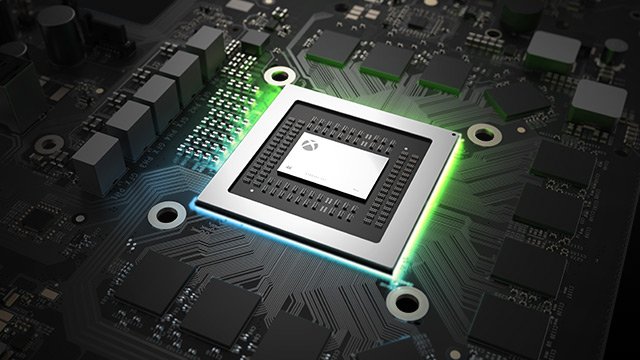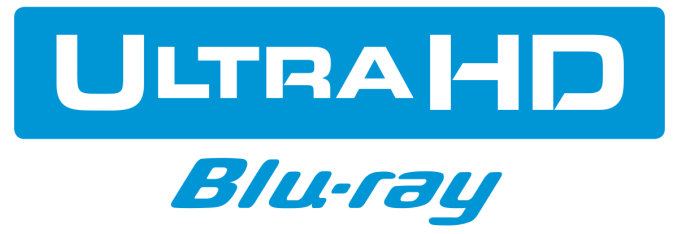The Xbox One X Review: Putting A Spotlight On Gaming
by Brett Howse on November 3, 2017 3:01 AM EST- Posted in
- Consoles
- Microsoft
- Xbox One
- Xbox
- Xbox One X
Powering Xbox One X: The Scorpio Engine
The heart of the Xbox One X is a custom AMD APU, which Microsoft is dubbing the Scorpio Engine. This APU features eight CPU cores and forty GPU compute units, essentially making it a vastly more powerful version of the APU found in the original Xbox One. All of this is built on TSMC’s 16 nm fab process, packing seven billion transistors into 360 mm2. Amazingly, that’s almost exactly the same size die as the original Xbox One, although quite a bit larger than the 240 mm2 of the Xbox One S, which is also built on TSMC 16 nm. Thanks to quite a bit of disclosure from Microsoft between the time the Xbox Project Scorpio was announced, until the launch of the Xbox One X, we know quite a bit about what’s powering the latest console.
 Image Source: Digital Foundry
Image Source: Digital Foundry
Eight Custom CPU Cores
The original Xbox One featured eight CPU cores based on the AMD Jaguar microarchitecture, and the Xbox One X keeps that completely intact. There’s still eight cores, and they are still based on a slightly upgraded version of Jaguar. Microsoft stated the CPU performance increased 31% over the original console, and they achieved that with a frequency bump from 1.75 GHz to 2.3 GHz.
This likely came down to several factors. They may have been able to leverage Ryzen cores, but it would have been difficult to get Ryzen into the new APU on the timelines required. Jaguar is also going to take up less of their die space as well, which is important when you are limited by your total die budget, and as we saw with the Xbox One’s eSRAM, taking die space for non-GPU functions can be a problem. Finally, since the Xbox One X will be completely backwards compatible with the Xbox One, keeping the same CPU architecture likely makes this an easier transition.
Microsoft calls these custom CPU cores, and while we’ll likely never get all of the information on what’s custom on them, Microsoft has released a couple of details. In particular, these new CPU cores implement a page descriptor cache of nested translations, which is a fairly low level optimization to the cache design that allows Microsoft to offset some of the remaining overhead that comes from their use of virtual machines by better caching the VM's memory operations. This optimization gets the Scorpio Engine a few percent more in average CPU performance. But regardless, the custom x86 CPU is 31% faster than the original Xbox One thanks to a 31% higher frequency. Clearly the team’s testing and research showed that this was enough CPU for the expected requirements.
12 GB GDDR5 System Memory
Arguably the biggest change to the Xbox One X is the move from 8 GB of DDR3 with a 32 MB eSRAM buffer, to 12 GB of GDDR5 memory, clocked at 6.8 Gbps. This isn’t just because there’s more RAM, but more because it gets rid of the eSRAM. The Xbox One X has twelve 32-bit channels for the GDDR5, resulting in a 384-bit memory interface. Coupled with the 6.8 Gbps data rate, that provides 326 GB/s of system memory bandwidth. 9 GB of RAM is available to developers, with 3 GB reserved for the system to handle multi-tasking. The original plan for a 4K dashboard got dropped to provide more RAM to developers, so the 3 GB matches the same reservation as the original Xbox One console.
The original Xbox One had just 68.3 GB/s of system memory bandwidth, and compensated with a 102 GB/s bi-directional eSRAM buffer. The Xbox One X no longer requires that buffer, thanks to copious amounts of bandwidth for main memory, which frees up a lot of die space on the APU. I wonder what they’ll use that space for?
40 GPU Compute Units at 1172 MHz
Microsoft was able to invest almost all of the free die space from the removal of the eSRAM into improving the GPU. The Xbox One X ships with the most powerful GPU in any console, and features an AMD custom GPU.
The heart of the Xbox One X is a GPU that's roughly based on AMD’s GCN 4 (Polaris) architecture. It offers 40 compute units, 2560 stream processors, and 32 ROPs. For comparison, an AMD Radeon RX 480 offers 36 CUs, so the Xbox One X offers 11% more compute hardware than the RX 480. Compared to the PlayStation 4 Pro, the Xbox One X offers about 43% more shader throughput.
There’s of course more custom blocks here as well. A console designed for 4K and HDR still needs to work with SDR 1080p displays, and the Xbox display controller can supersample down from 4K to 1080p, or even 1440p, as needed. There’s media blocks for HEVC as well, to handle the 4K video requirements for Blu-Ray and streaming, and the Xbox Game Capture can also capture at 4K now.
Storage: SATA HDD
For those hoping for all flash based storage in their console, those days are still a long way off. The amount of storage needed for games, especially those with 4K assets, is copious, to say the least, so for now we’re stuck with spinning disks. Digital Foundry reports that the Xbox One X will have 50% more bandwidth to the hard drive, which likely means the latest model is finally SATA III, rather than SATA II, for the 2.5” HDD. Unlike the short lived Xbox One Elite, there doesn’t appear to be any SSHD options at this time.
If you need extra storage, the Xbox One supports external USB storage. It would be nice if Microsoft had made it possible to replace the internal storage easily, but so far, they don’t seem to want to do that. Adding external storage is pretty simple though.
UHD Blu-Ray
Like the Xbox One S, the Xbox One X ships with a UHD Blu-Ray drive, allowing you to play UHD/4K movies with HDR support. There’s no support for Dolby Vision currently.
Hardware Summary
There’s a lot of performance packed into the new Xbox One X. Microsoft was too conservative with the original Xbox One, and they seem to be out to prove that they won’t make that mistake again. This is a console designed to target 4K right from the start. As to how successful they will be, that will depend on the developers, and the ever-evolving trade-off between more complex scenes, and higher resolution, but with a GPU that is almost five times more powerful than the original Xbox One, coupled with 12 GB of 384-bit GDDR5, and a faster CPU, the aim looks like its on target.













128 Comments
View All Comments
cmdrdredd - Saturday, November 4, 2017 - link
PS4 is doing the same thing.ncsaephanh - Friday, November 3, 2017 - link
Very cool how they basically put a 480's worth of gpu performance and still are able to run the console as quietly as they do. More competition is always a good thing, and I can't wait to see where we are 5 years from now.Drumsticks - Friday, November 3, 2017 - link
Thanks for the review, it was a nice read.Look at that power draw in Gears of War 4 (172W). I know that we can't make direct comparisons, but I wish we could find out if the One X was pegging the GPU at full load during that time. If so, a fully loaded GPU with slightly more hardware (6TF vs like 5.6?), and an 8 core CPU is drawing less power from the wall than an RX 480/580 draws by itself?
It's hard to say for sure unless we could somehow view GPU/CPU load at the same time, but still, how? It's hard to not come to the conclusion that this APU is much more efficient than Polaris. Just how much worse is GloFo versus TSMC Finfet?
InlineV - Friday, November 3, 2017 - link
Microsoft has developed a process for matching the power supply to the CPU/GPU to optimize the power profile at the factory. They haven't released details for how they do that but the results seem to speak for themselves.Stochastic - Friday, November 3, 2017 - link
I just wanted to chime in and say well done! It's great to see Anandtech publish articles on popular consumer tech in a timely fashion. This is the best Xbox One X review I've seen yet--all the details you include are the reason I've continued reading Anandtech after all these years.Brett Howse - Friday, November 3, 2017 - link
Thanks!Wolfpup - Friday, November 3, 2017 - link
Fantastic article, as we expect from Anandtech!So bizarre about that Netflix bug, that they haven't fixed it (how hard can it be?) and replicated it on the PS4 Pro?!?
I love that the Xbox One has at least some backwards compatibility. Love that they're worrying about noise the system makes. Love the use of normal non-proprietary batteries.
Only aspects of the design I don't like are the non-replaceable hard drive (makes me parinoid it's going to die...although IF they do backwards compatibility from here on out, that's less of an issue) and the weird save system. I like being able to manually back up my saves! These cloud servies are flaky in my experience, and that's besides that I might not always want a save on someone's server, nor to use GB of bandwidth backing up saves (and how much space do they give us?)
But mostly it's a great design, and pretty darned exciting.
I'm controlling myself and not buying it until next year, as I've got a huge backlog, and among other things want to get through my PS4 exclusives first, but I'm going to standardize on Xbox One X for the backwards compatibility and controller with normal batteries.
Chad - Friday, November 3, 2017 - link
Great article!!Very impressed with msft right now, it seems they really took their time and properly engineered this thing. Low power, low noise, compact and efficient design packing a ton of power. Both hardware and software (the new OS) are homeruns for a (relatively) low cost. Impressive!
Rufnek - Monday, November 6, 2017 - link
This would have been more impressive if they had attempted to do this for the actual One release.Instead the users got a HUGE console, with external power brick, a useless Kinect and garbage DDR3 ram with a 'special' 32mb bandwidth boost. What a joke that was compared to the smaller, faster, power brick included, GDDR5 console. The X is what M$ should have been aiming for. Hind sight is 20/20
Brett Howse - Friday, November 3, 2017 - link
Yes I'd like them to add removable storage, but I can also understand they want the packaging as clean as they can make it. USB storage is simple and effective.I've never had an issue with game backups to Xbox Live and to be honest I kind of prefer having it synced, especially with Play Anywhere now being a thing.